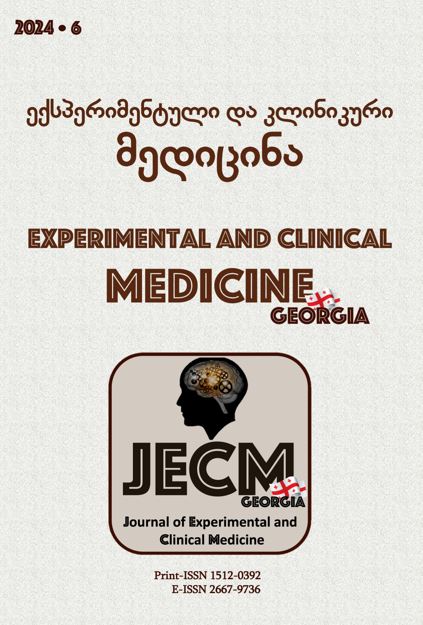THE ALLEVIATING EFFECT OF ZINC SULFATE ON THE LONG-TERM POSTNATAL ALCOHOL-INDUCED MORPHOLOGICAL, BEHAVIORAL AND METABOLIC IMPAIRMENTS IN THE OFFSPRING OF ALCOHOLIZED FEMALE ALBINO RATS
DOI:
https://doi.org/10.52340/jecm.2024.06.09Keywords:
Prenatal alcohol exposure, limbic system, oxidative stress, zinc sulfateAbstract
Background: The present work aimed to assess morphological, behavioral, and metabolic changes in the offspring of female white rats given 15% ethanol solution during pregnancy and to address the possibility of correcting ethanol-induced impairments at long-term developmental consequences using the antioxidant Zinc Sulfate.
Methods: The research involved three groups of white mongrel rats: 1- 6-month-old intact rats (7 animals). Group 2 - was the 6-month-old offsprings of females, who consumed a 15% ethanol solution during pregnancy, and group 3 was 6-month-old offsprings of alcoholized females given Zinc sulfate (5 mg/kg) in their morning feed.
The total number of neurons in the limbic system's cortical and subcortical structures was counted. Spatial learning and memory formation were estimated in the elevated-type multiway labyrinth. Oxidative stress was measured using the FRAS5 photometric system.
Results: Alcohol consumption during pregnancy induces long-lasting changes during the postnatal period (up to 6 months). These changes are manifested through a reduction in the number of neurons and glial cells in the cortical and subcortical structures of the limbic system. Zinc sulfate acts as an antioxidant and reduces oxidative stress levels, leading to an improvement in the learning process and a decreased level of cell death.
Conclusion: Zinc sulfate acts as an antioxidant and reduces oxidative stress levels, leading to an improvement in the learning process and a decreased level of cell death. However, it cannot completely reverse the changes caused by alcohol consumption.
Downloads
References
Chung DD, Pinson MR, Bhenderu LS, Lai MS, Patel RA, Miranda RC. Toxic and Teratogenic Effects of Prenatal Alcohol Exposure on Fetal Development, Adolescence, and Adulthood. Int J Mol Sci. 2021; 22(16):8785.
Thomas JD, Warren KR, Hewitt BG. Fetal alcohol spectrum disorders: From research to policy. Alcohol Res. Health. 2010; 33:118–126.
Foltran F, Gregori D, Franchin L, Verduci E, Giovannini M. Effect of alcohol consumption in prenatal life, childhood, and adolescence on child development. Nutr Rev. 2011; 69(11):642-59.
Brocardo PS, Gil-Mohapel J, Christie BR. The role of oxidative stress in fetal alcohol spectrum disorders. Brain Res Rev. 2011; 67(1-2):209-25.
Goodlett CR, Horn KH. Mechanisms of alcohol-induced damage to the developing nervous system. Alcohol Res Health. 2001; 25(3):175-84.
Harvey RE, Berkowitz LE, Hamilton DA, Clark BJ. The effects of developmental alcohol exposure on the neurobiology of spatial processing. Neurosci Biobehav Rev. 2019; 107:775-794.
Miyake K, Yagi S, Aoki Y, Shikano Y, Ikegaya Y, Sasaki T. Acute Effects of Ethanol on Hippocampal Spatial Representation and Offline Reactivation. Front Cell Neurosci. 2020; 14:571175.
Mirescu C, Gould E. Stress and adult neurogenesis. Hippocampus. 2006; 16:233–8.
Choi IY, Allan AM, Cunningham LA. Moderate fetal alcohol exposure impairs the neurogenic response to an enriched environment in adult mice. Alcohol Clin Exp Res. 2005; 29:2053–62.
Kumar S, Porcu P, Werner DF, Matthews DB, Diaz-Granados JL, Heet et al. The role of GABAA receptors in the acute and chronic effects of ethanol: a decade of progress. Psychopharmacology 2009;205:529–564.
Abrahao KP, Salinas AG, and Lovinger DM. Alcohol and the brain: neuronal molecular targets, synapses, and circuits. Neuron 2017; 96:1223–38.
Berman RF, Hannigan JH. Effects of prenatal alcohol exposure on the hippocampus: spatial behavior, electrophysiology, and neuroanatomy. Hippocampus. 2000; 10(1):94-110.
Heaton MB, Moore DB, Paiva M, Gibbs T, Bernard O. Bcl-2 overexpression protects the neonatal cerebellum from ethanol neurotoxicity. Brain Research. 1999; 817:13–18.
Svanidze IK, Museridze DP, Sanikidze TV, Didimova EV, Gegenava LG, Gvinadze NN, Tsaishvili TS, Z. Khanaeva, Aptsiauri KN. The study of pre- and postnatal influence of ethanol on cortical and subcortical structures of the limbic system in the offspring of alcoholized female albino rats, as well as the possibility of correcting of disorders caused by ethanol with antioxidants, In book: “Advance in Chemistry Research”, Editors: James C. Taylor, Nova Science Publishers, 2015; 27: 33-62.
Mitagvariya NP. Stability of Circulatory Support of Functions of the Brain [in Russian]. 1983, Metsniereba.
Lovinger, D. M. Alcohols and neurotransmitter gated ion channels: past, present and future. Naunyn Schmiedebergs Arch. Pharmacol. 1997; 356;267–282
Wu D, Cederbaum AI. Alcohol, oxidative stress, and free radical damage. Alcohol Res Health. 2003; 27(4):277-84.
Miller MW, Robertson S. Prenatal exposure to ethanol alters the postnatal development and transformation of radial glia to astrocytes in the cortex. Journal of Comparative Neurology. 1993; 337:253–66.
Staples MC, Mandyam CD. Thinking after Drinking: Impaired Hippocampal-Dependent Cognition in Human Alcoholics and Animal Models of Alcohol Dependence. Front Psychiatry. 2016; 7:162.
Shimizu K, Matsubara K, Uezono T, Kimura K, Shiono H. Reduced dorsal hippocampal glutamate release significantly correlates with the spatial memory deficits produced by benzodiazepines and ethanol. Neuroscience 1998; 83:701–6.






